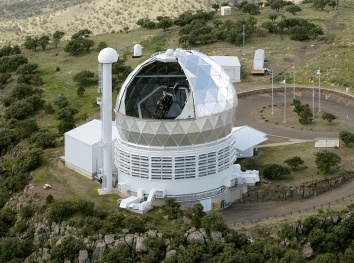Astronomers Discover Multi-Planet System; May Alter Theories of Planet Formation
23 May 2007
FORT DAVIS, Texas — University of Texas at Austin astronomers William Cochran and Michael Endl, working with graduate students Robert Wittenmyer and Jacob Bean, have used the 9.2-meter Hobby-Eberly Telescope (HET) at McDonald Observatory to discover a system of two Jupiter-like planets orbiting a star whose composition might seem to rule out planet formation. This NASA-funded study has implications for theories of planet formation.
Cochran and Endl have been monitoring the star, HD 155358, since 2001 using the High Resolution Spectrograph on HET. Their measurements of its “radial velocity,” or motion toward and away from Earth, show that the star has a wobble in its motion, which is caused by unseen companions tugging on the star.
HD 155358 is slightly hotter than the Sun, but a bit less massive. Most important, it only contains 20 percent as much of the chemical elements called “metals” — elements heavier than hydrogen or helium — as the Sun. Along with one other star (called HD 47536), it contains the fewest metals of any star found to harbor planets.
Bean specializes in studying the metal contents of stars. His in-depth studies of the star’s spectrum revealed its metal-poor nature, and allowed him to deduce the star’s age of roughly10 billion years.
One planet has an orbital period of 195 days and, at a minimum, is 90 percent as massive as Jupiter. It orbits HD 155358 at a distance of 0.6 AU. (An astronomical unit, or AU, is the Earth-Sun distance of 150 million km, or 93 million miles.) The other planet orbits HD 155358 in 530 days, with a minimum mass half that of Jupiter, at a distance of 1.2 AU.
Wittenmyer used the University of Texas at Austin supercomputer “Lonestar” to calculate the two massive planets’ orbits 100 million years into the future. The planets’ orbits are not circular, and they orbit close to each other and thus interact gravitationally — they push each other around.
“It’s like a dance,” Endl said. He explained that “Rob’s calculations show us how the orbits change over time: first more eccentric, then more circular, and back again.” The system is stable, Endl said, and the pattern repeats about every 3,000 years.
According to Wittenmyer, “The planets are trading eccentricity with each other. When one orbit is more circular, the other is more eccentric.”
The combination of massive planets orbiting a metal-poor star has consequences for theories of planet formation.
“There are two competing planet-formation models,” Endl said. Those models are known as the “core accretion model” and the “disk instability model.”
Both models start with a rotating cloud with a star forming at its center. As it rotates, the cloud flattens into a disk. Over time, dust in the disk begins to clump together to form the seeds that will eventually become planets. Where the two models differ is in terms of timescale.
In the core accretion model, a Jupiter-like planet forms in a two-step process. Over about a million years, a proto-planetary “core” several times the mass of Earth forms through gravitational accumulation of solid materials. When it reaches this mass, it has enough gravity to then pull huge amounts of gas onto itself. Over several million more years, it grows into a gas giant planet.
This model relies on large amounts of heavy elements to be present in the disk — and, of course, in the star— to form the cores, Endl said.
“Most of the planets found using the radial velocity technique are found around metal-rich stars,” he said. “That argues for the ‘core accretion’ model. Many astronomers in this field agree that the higher fraction of planets around metal-rich stars is supporting evidence for the core-accretion model.”
”Having this process happen to form not just one, but two, planets around a star that had so little solid material available for planet-building is quite remarkable.” Cochran said.
The competing model of planet formation is called the disk instability model. It argues that the rotating disk of gas and dust around the forming star becomes unstable very soon after the disk forms, causes the disk to break into giant clumps. Gravity within each clump can cause the gas to collapse under its own gravity, forming giant planets in only several hundred years.
“Gas giant planets formed this way might not have any solid core at all,” Endl said.
Cochran and his colleagues argue that HD 155358 could have formed the two planets through either method of planet formation.
“The major result of our discovery is that these planets required a very massive disk to form, several times more massive than we think our solar system disk was,” Endl said. “This demonstrates that disk masses can vary significantly and might even be the most crucial factor in planet formation.”
Cochran and colleagues first began using radial velocity techniques to search for planets from McDonald Observatory in the late 1980s, using the 2.7-meter Harlan J. Smith Telescope. The program continues today on both the Smith Telescope and HET, and Cochran’s team has found planets orbiting several stars.
The Hobby-Eberly Telescope is a joint project of The University of Texas at Austin, The Pennsylvania State University, Stanford University, Ludwig-Maximilians-Universität München and Georg-August-Unversität Göttingen.
— END —
Note to Editors : More information is available online here.






